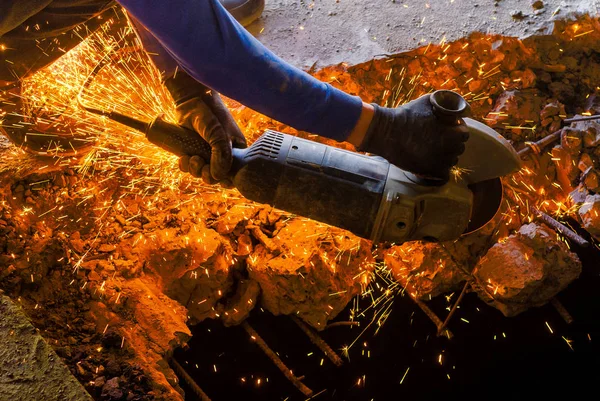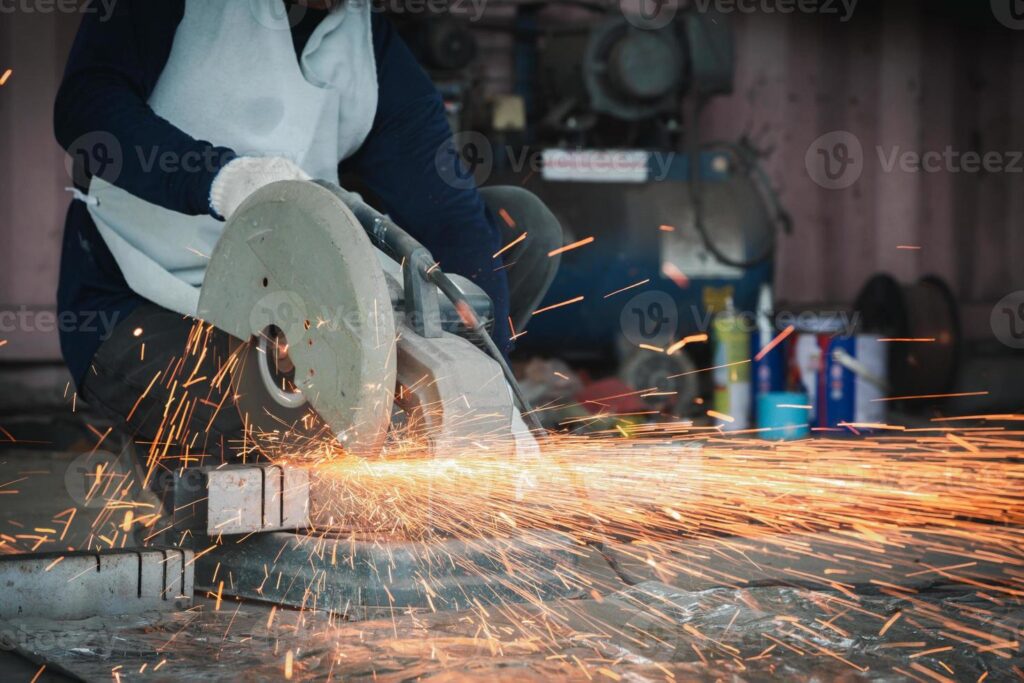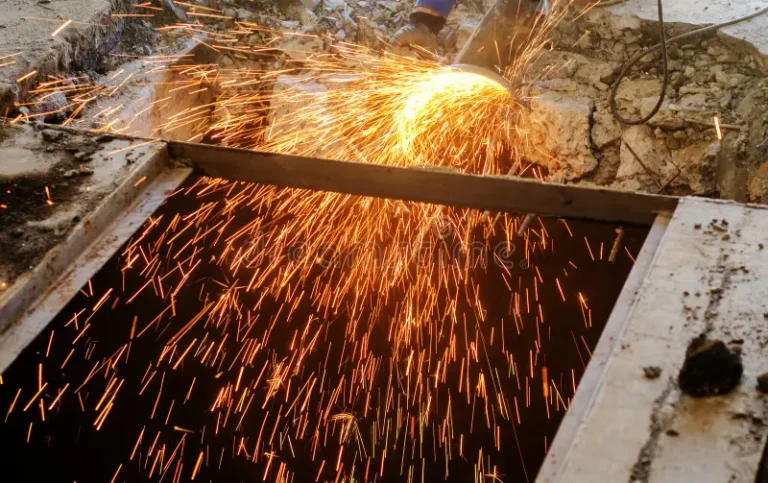Certain metals can produce sparks when they come into contact with concrete, typically due to their hardness and the force of impact. Steel is a common metal that sparks on concrete because it is hard and durable, allowing tiny particles to shear off and ignite upon impact.
Also, Titanium even harder than steel, can create brighter and more numerous sparks. While aluminum is softer and less likely to spark, it can still produce sparks under specific conditions, such as when struck forcefully or if the aluminum is thin.
Additionally, materials like Ferrocerium, designed for sparking, and non-metals like flint and quartz can also generate sparks when struck against concrete. Understanding these properties is important for various applications, from industrial processes to outdoor activities.
Characteristics of Metal Sparks

Metal sparks exhibit various characteristics that can provide valuable information about the type of metal involved and the conditions under which the sparks are generated. These characteristics include
- Spark Color:
- Different metals produce it of varying colors when they interact with a hard surface. For example:
- Steel typically produces white sparks.
- Cast iron is often more orange or reddish.
- Aluminum can be white to yellow.
- Different metals produce it of varying colors when they interact with a hard surface. For example:
- Spark Shape:
- The shape of it can indicate the type of metal. For instance:
- Steels are often star-shaped with multiple branches.
- Aluminum may be more rounded or irregular in shape.
- Spark Duration:
- The duration of it, or how long it remains visible, can be an indicator of the metal’s composition and hardness.
- Harder metals may produce longer-lasting ones.
- Spark Trail:
- The path or trail left by sparks can provide information about the metal’s properties.
- Some metals may leave a straight trail, while others may have a more erratic path.
- Spark Intensity:
- The brightness or intensity of it can be influenced by factors such as the metal’s hardness and the speed of impact.
- Harder metals tend to produce more intense ones.
- Spark Temperature:
- The temperature of it can vary among different metals, with some producing hotter sparks than others.
- Spark Pattern:
- The overall pattern formed by it can be distinctive for certain metals.
- Analyzing the arrangement and dispersion of sparks can aid in metal identification.
- Sound Produced:
- In some cases, the interaction of metal with a hard surface can produce audible sounds. The sound can be characteristic of certain metals.
- Quantity of Sparks:
- The number of them generated can be related to the composition and hardness of the metal.
- Harder metals often produce more sparks.
- The number of them generated can be related to the composition and hardness of the metal.
- Spark Size:
- The size of sparks can vary and may be influenced by the type of metal and the conditions of impact.
Factors Affecting Whether a Metal Will Spark on Concrete
I. Metal Composition:
- The unique composition of metals influences the color, intensity, and pattern of sparks produced upon interaction with a hard surface.
II. Metal Hardness:
- Harder metals are more prone to sparking, as their increased hardness allows them to shear off smaller particles that heat up to the point of ignition, resulting in more intense and longer-lasting sparks.
III. Speed and Force of Impact:
- The speed and force with which a metal impacts a surface directly affect spark characteristics. Faster and more forceful impacts typically generate more energetic spark displays.
IV. Surface Conditions:
- The condition of the surface being struck plays a role in spark patterns. Smooth or rough surfaces can influence the trajectory and dispersion of them.
V. Alloy Compositions:
- Alloys, combinations of different metals, showcase unique spark characteristics influenced by the specific elements present and their proportions within the alloy.
VI. Temperature:
- The temperature at which they are generated varies among metals and can impact spark color and intensity.
VII. Metal Purity:
- Impurities in metals can alter spark patterns. Pure metals tend to produce more consistent and predictable sparks compared to impure counterparts.
VIII. Kinetic Energy Transfer:
- The transfer of kinetic energy during impact is a key factor in it formation. Metals with higher kinetic energy may produce more sparks or sparks with increased brightness.
IX. Surface Texture:
- The texture of the surface being struck influences spark dispersion and trajectory. Smooth surfaces can allow for more controlled spark patterns.
X. Environmental Conditions:
- Factors like humidity and atmospheric conditions can influence its behavior, leading to unique characteristics or patterns in certain environments.
XI. Metal Microstructure:
- The internal structure of a metal, including grain size and crystal arrangement, impacts spark formation. Metals with different microstructures may produce varied patterns.
XII. Presence of Alloying Elements:
- Specific elements added to metals as alloys contribute to overall spark characteristics. For instance, the addition of tungsten or molybdenum can influence color and intensity.
Common Metals and Their Spark Characteristics
I. Steel:
- Spark Color: White
- Spark Pattern: Star-shaped with multiple branches for high-carbon steel, more forks for mild steel, and bushy for high-carbon tool steel.
- Spark Duration: Moderate to long-lasting.
II. Cast Iron:
- Spark Characteristics: Very short sparks starting at the grinding wheel.
III. Aluminum:
- Spark Color: White to yellow
- Spark Pattern: Rounded or irregular in shape.
IV. Titanium:
- Spark Characteristics: Brilliant, blinding, white sparks despite being a non-ferrous metal.
V. High-Speed Steel:
- Spark Characteristics: Faint red sparks sparking at the tip.
VI. Stainless Steel (300-series):
- Spark Characteristics: Less dense sparks, orange to straw in color, no forking.
VII. Stainless Steel (310-series):
- Spark Characteristics: Shorter and thinner sparks than 300-series, red to orange, no forking.
VIII. Stainless Steel (400-series):
- Spark Characteristics: Similar to 300-series sparks, slightly longer with forks at the ends.
IX. Nickel and Cobalt High-Temperature Alloys:
- Spark Characteristics: Thin, very short, dark-red sparks, no forking.
X. Cemented Carbide:
- Spark Characteristics: Sparks under 3 inches, dark red, no forking.
XI. Ferrocerium:
- Characteristics: Pyrophoric alloy designed to produce sparks.
- Spark Formation: Made from iron, cerium, and other metals, ferrocerium easily ignites when struck against a hard surface, creating a brilliant shower of sparks.
Applications and Implications of Metal Spark Analysis

| I. Metal Identification: | |
| – Forensic Investigations | Analyzing metal sparks aids in identifying materials at crime scenes. |
| – Quality Control | Ensuring product integrity in manufacturing by verifying metal composition. |
| II. Safety Measures: | |
| – Protective Gear | Tailoring safety equipment based on the specific sparking characteristics of metals. |
| – Controlled Environments | Implementing safety protocols in environments where sparking metals are present. |
| III. Industrial Processes: | |
| – Metallurgy | Optimizing metal production processes through spark analysis. |
| – Material Selection | Choosing appropriate metals for specific applications based on sparking behavior. |
| IV. Fire Starting and Survival: | |
| – Outdoor Activities | Utilizing spark-producing metals in camping and survival gear for fire ignition. |
| – Emergency Preparedness | Incorporating sparking materials for reliable fire-starting tools. |
| V. Quality Assurance: | |
| – Manufacturing | Ensuring consistency and quality in metal-based products through spark analysis. |
| – Material Testing | Verifying material properties for adherence to industry standards. |
| VI. Environmental Considerations: | |
| – Safety Protocols | Establishing safety measures in environments where sparking metals can pose risks. |
| – Regulatory Compliance | Adhering to environmental and safety regulations related to sparking materials. |
| VII. Research and Development: | |
| – Innovation | Inspiring advancements in materials science through a deeper understanding of sparking characteristics. |
| – Material Engineering | Developing new alloys and materials with controlled sparking properties. |
| VIII. Fire Safety Training: | |
| – Education | Enhancing understanding of sparking metals for firefighters and emergency responders. |
| – Training Simulations | Incorporating realistic sparking scenarios in training exercises. |
| IX. Forensic Analysis: | |
| – Crime Scene Investigations | Providing valuable insights into metal fragments found at crime scenes. |
| – Evidence Examination | Supporting forensic analysts in identifying and linking metallic materials. |
FAQ’s
1. What material makes sparks on concrete?
Metals such as aluminum, titanium, and iron (as a ferrous metal) are known to produce sparks on concrete due to their ability to generate frictional sparks upon impact.
2. What metal makes the most sparks?
Metals with low thermal conductivity, such as titanium and zirconium, are especially good at producing sparks. They are commonly used in applications like fireworks.
3. Does stainless steel spark on concrete?
Yes, stainless steel, being a ferrous-based alloy, will produce sparks when struck against concrete or a hard surface. It cannot be classified as non-sparking.
4. Does titanium spark on concrete?
Yes, Titanium can produce sparks on concrete. Unlike aluminum, which is too soft, titanium is hard enough for friction to heat up and ignite bits that fly off upon impact.
5. What types of metal spark?
Materials made of carbon steel, stainless steel, cast iron, or wrought iron are likely to produce sparks. Non-ferrous metals like aluminum, copper, brass, silver, and lead can also spark.
6. Can aluminium cause a spark?
Yes, Pure, non-ferrous aluminum is non-sparking. However, sparks may be generated if the aluminum is in the form of alloys, commonly used for reasons such as availability, cost, and strength.
7. Does stainless steel spark?
Yes, items made from carbon steel, stainless steel, cast iron, or wrought iron have the potential to produce sparks. Non-ferrous metals, including aluminum, can be used to create non-sparking tools.
8. Can steel cause a spark?
Yes, Spark incendivity has been reported for various types of steel, including stainless steel, tempered steel, and mild steel, under certain friction configurations. Data for different mechanical friction situations are still limited.
Final Words
In conclusion, the propensity of metals to spark on concrete is influenced by factors such as hardness, the force of impact, and specific metal characteristics.
Furthermore, Steel known for its hardness and durability, frequently produces sparks on concrete as it shears off tiny, heated particles upon impact. Titanium, even harder than steel, generates more brilliant sparks.
While aluminum is generally less prone to sparking, it can still produce sparks under specific conditions. Additionally, specialized sparking materials like Ferrocerium, and non-metals such as flint and quartz, contribute to the spectrum of metals that exhibit this behavior.
So, understanding the sparking properties of metals on concrete is not only essential for various industrial applications but also for safety considerations and outdoor activities where this knowledge can be applied effectively.

